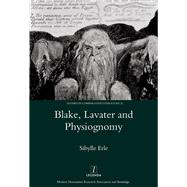- ISBN: 9781906540692 | 1906540691
- Cover: Hardcover
- Copyright: 12/1/2010
William Blake never travelled to the continent, and yet his creation myth is far more European than has so far been acknowledged. His early illuminated books, of the 1790s, run alongside his professional work as a copy-engraver on Henry Hunter's translation of Johann Caspar Lavater's Essays on Physiognomy (1789-98) - work in which Blake helped to make a likeness of a book about likenesses. For Blake, as for Lavater, Henry Fuseli, Joshua Reynolds and others of his age, the art of the portrait was to find the right balance between likeness and type. Blake, Lavater, and Physiognomy demonstrates how the problems occurring during the production of the Hunter translation resonate in Blake's treatment of the Genesis story. Blake takes us back to the creation of the human body, and interrogates the idea that 'God created man after his own likeness.' He introduces the 'Net of Religion', a device which presses the human form into material shape, giving it personality and identity. As Erle shows, Blake's startlingly original take on the creation myth is informed by Lavater's pursuit of physiognomy: the search for divine likeness, traced in the faces of their contemporary men.







